
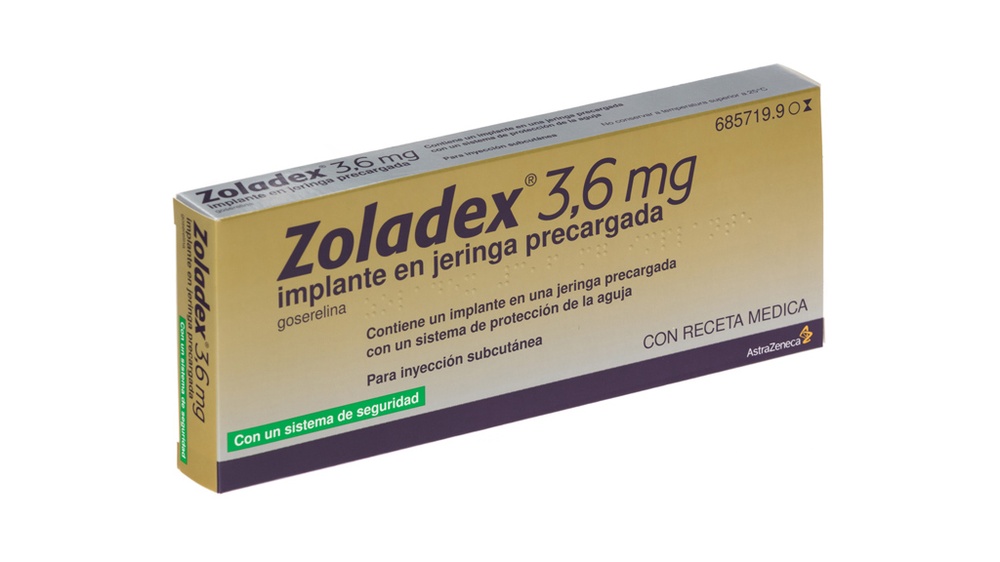
ЗОЛАДЕКС 3,6 мг ИМПЛАНТ В ПРЕДНАПОЛНЕННОМ ШПРИЦЕ

Спросите врача о рецепте на ЗОЛАДЕКС 3,6 мг ИМПЛАНТ В ПРЕДНАПОЛНЕННОМ ШПРИЦЕ

Инструкция по применению ЗОЛАДЕКС 3,6 мг ИМПЛАНТ В ПРЕДНАПОЛНЕННОМ ШПРИЦЕ
Введение
Инструкция: информация для пользователя
Золадекс3,6 мг имплантат в предварительно заполненной шприце
гозерелин
Прочитайте внимательно всю инструкцию перед началом использования этого лекарства, поскольку она содержит важную информацию длявас.
- Сохраните эту инструкцию, поскольку вам может потребоваться перечитать ее.
- Если у вас есть какие-либо вопросы, проконсультируйтесь с вашим врачом или фармацевтом.
- Это лекарство было назначено только вам, и его не следует давать другим людям, даже если они имеют те же симптомы, что и вы, поскольку оно может нанести им вред.
- Если вы испытываете побочные эффекты, проконсультируйтесь с вашим врачом или фармацевтом, даже если это побочные эффекты, которые не указаны в этой инструкции. См. раздел 4.
Содержание инструкции:
- Что такое Золадекс 3,6 мг и для чего он используется.
- Что вам нужно знать перед началом использования Золадекса 3,6 мг.
- Как использовать Золадекс 3,6 мг.
- Возможные побочные эффекты.
- Хранение Золадекса 3,6 мг.
Содержание упаковки и дополнительная информация.
1. Что такое Золадекс 3,6 мг и для чего он используется
Золадекс 3,6 мг относится к группе лекарств, называемых антигормональными, что означает, что он влияет на уровни различных гормонов (естественных химических веществ, производимых организмом). У мужчин он снижает уровни мужского гормона, тестостерона, и у женщин - уровни женского гормона, эстрогена.
Золадекс 3,6 мг используется:
- У мужчин для лечения определенных типов рака простаты.
- У женщин для:
- лечения определенных типов рака молочной железы.
- лечения эндометриоза, который является доброкачественным заболеванием, при котором ткань, обычно растущая внутри матки, также образуется вне матки.
- лечения миомы матки, которые являются доброкачественными узлами, образующимися в матке.
- снижения толщины слизистой оболочки матки (эндометрия) перед операцией, называемой абляцией эндометрия, которая включает удаление слизистой оболочки матки.
контроля высвобождения яйцеклеток из яичников в рамках лечения бесплодия.
2. Что вам нужно знать перед началом использования Золадекса 3,6 мг
Не используйте Золадекс 3,6 мг
- Если вы аллергичны к гозерелину или любому другому компоненту этого лекарства (перечисленному в разделе 6).
- Прежде чем получить инъекцию, сообщите вашему врачу, если вы беременны, думаете, что можете быть беременной, или кормите грудью. Золадекс 3,6 мг не должен использоваться, если вы беременны или пытаетесь забеременеть, за исключением случаев, когда это лекарство используется в рамках лечения бесплодия. Золадекс 3,6 мг не должен использоваться во время кормления грудью (см. раздел "Фертильность, беременность и кормление грудью" ниже).
Предостережения и меры предосторожности
- Проконсультируйтесь с вашим врачом или фармацевтом перед началом использования Золадекса 3,6 мг.
- Были зарегистрированы случаи депрессии у пациентов, принимающих Золадекс 3,6 мг, которая может быть тяжелой. Если вы принимаете Золадекс 3,6 мг и испытываете депрессию, сообщите об этом вашему врачу.
- Сообщите вашему врачу, если у вас есть какие-либо сердечно-сосудистые заболевания или если вы проходите лечение для них, включая лекарства для контроля сердечного ритма (аритмии). Риск проблем с сердечным ритмом может увеличиться при использовании Золадекса 3,6 мг.
- Сообщите вашему врачу, если у вас есть гипертония (высокое кровяное давление).
- Немедленно сообщите вашему врачу, если вы испытываете боль и гематому в животе или другие симптомы тяжелого кровотечения, такие как затруднение дыхания, головокружение, низкое кровяное давление и/или изменение уровня сознания, которые могут быть результатом повреждения кровеносных сосудов в месте инъекции, вызванного при введении Золадекса 3,6 мг. (см. раздел 4).
- Лечение Золадексом 3,6 мг может привести к положительным результатам в тестах на допинг.
В случае госпитализации сообщите медицинскому персоналу, что вы проходите лечение Золадексом 3,6 мг.
Мужчины:
- Прежде чем начать лечение этим лекарством, сообщите вашему врачу, если:
- у вас были какие-либо трудности с мочеиспусканием или вы испытывали дискомфорт в нижней части спины, или
- у вас есть диабет.
- Лекарства этого типа могут вызвать потерю кальция в костях (снижение их плотности). Если у вас есть какие-либо заболевания, которые влияют на прочность костей, или факторы риска остеопороза [например, хроническое злоупотребление алкоголем, курение, длительное лечение противоэпилептическими препаратами (лекарствами для лечения эпилепсии или судорог) или кортикостероидами (типом противовоспалительных препаратов), семейная история остеопороза], сообщите об этом вашему врачу или медсестре.
Женщины:
- Лекарства этого типа могут вызвать потерю кальция в костях. Часть этой потери может быть восстановлена после окончания лечения. Если у вас есть какие-либо заболевания, которые влияют на силу костей, или факторы риска остеопороза [например, хроническое злоупотребление алкоголем, курение, длительное лечение противоэпилептическими препаратами (лекарствами для лечения эпилепсии или судорог) или кортикостероидами, семейная история остеопороза и недоедание, такое как нервная анорексия], сообщите об этом вашему врачу или медсестре, поскольку вероятно, что снижение плотности костей будет более вредным. Если вы используете Золадекс 3,6 мг для лечения эндометриоза, ваш врач может назначить дополнительное лечение для противодействия этому снижению плотности костей.
- Сообщите вашему врачу, если у вас есть вагинальное кровотечение, которое не прекращается после первого месяца лечения Золадексом 3,6 мг.
- Если вы используете Золадекс 3,6 мг для лечения эндометриоза или миомы матки, максимальная продолжительность лечения этим лекарством не должна превышать 6 месяцев.
- Во время лечения Золадексом 3,6 мг и до тех пор, пока менструация не восстановится после окончания лечения, следует использовать методы контрацепции, такие как презерватив или диафрагма, и никогда не использовать пероральные контрацептивы ("пиллу"). Это предупреждение не распространяется на случаи, когда Золадекс 3,6 мг используется в качестве лечения бесплодия.
Дети и подростки
Золадекс 3,6 мг не показан для использования у детей.
Использование Золадекса 3,6 мг с другими лекарствами
Сообщите вашему врачу, фармацевту или медсестре, если вы используете, недавно использовали или можете использовать любое другое лекарство.
Золадекс 3,6 мг может взаимодействовать с некоторыми лекарствами, используемыми для лечения проблем с сердечным ритмом (например, хинидин, процаинамид, амиодарон и соталол) или может увеличить риск проблем с сердечным ритмом при использовании с другими лекарствами (например, метадон, используемый для обезболивания и детоксикации, моксифлоксацин, антибиотик, антипсихотики, используемые для лечения тяжелых психических заболеваний).
Беременность и кормление грудью
Если вы беременны или кормите грудью, думаете, что можете быть беременной, или планируете забеременеть, проконсультируйтесь с вашим врачом, фармацевтом или медсестрой перед использованием этого лекарства.
Золадекс 3,6 мг не должен использоваться, если вы беременны или пытаетесь забеременеть, за исключением случаев, когда это лекарство используется в рамках лечения бесплодия. Золадекс 3,6 мг не должен использоваться во время кормления грудью.
Вождение и использование машин
Нет данных, которые бы указывали на то, что Золадекс 3,6 мг влияет на способность управлять транспортными средствами или использовать машины.
3. Как использовать Золадекс 3,6 мг
Следуйте точно инструкциям по введению этого лекарства, указанным вашим врачом.
В случае сомнений проконсультируйтесь снова с вашим врачом, фармацевтом или медсестрой.
Помните, что вам вводят лекарство.
Ваш врач укажет продолжительность лечения Золадексом 3,6 мг. Не прекращайте лечение до тех пор, пока ваш врач не скажет об этом.
Золадекс 3,6 мг вводится в виде инъекции вашим врачом или медсестрой, которые следуют инструкциям на этикетке упаковки для правильного использования.
Золадекс 3,6 мг обычно вводится под кожу каждые 28 дней.
Важно продолжать лечение Золадексом 3,6 мг, даже если вы чувствуете себя хорошо, пока ваш врач не решит прекратить лечение.
Если у вас есть какие-либо другие вопросы о использовании этого продукта, проконсультируйтесь с вашим врачом или фармацевтом.
4. Возможные побочные эффекты
Как и все лекарства, это лекарство может вызывать побочные эффекты, хотя не все люди испытывают их.
- При введении Золадекса 3,6 мг инъекция может вызвать повреждение в месте введения, включая повреждение кровеносных сосудов в животе. В редких случаях это может привести к тяжелому кровотечению. Немедленно обратитесь за медицинской помощью, если вы заметите какие-либо из следующих симптомов:
Боль в животе, вздутие живота, затруднение дыхания, головокружение, низкое кровяное давление и/или любое изменение уровня сознания. Эти симптомы могут быть признаками тяжелого кровотечения, вызванного случайным повреждением кровеносного сосуда в животе при введении Золадекса 3,6 мг.
- Побочные эффекты, сообщенные у женщин:
Очень часто (может затронуть более 1 из 10 человек)
- Приливы, потливость. Эти побочные эффекты могут продолжаться после прекращения лечения Золадексом 3,6 мг.
- Снижение либидо.
- Сухость влагалища.
- Акне, обычно в первый месяц лечения Золадексом 3,6 мг.
- Увеличение размера молочных желез.
- Реакции в месте инъекции, такие как боль, появление синяков, кровотечение, покраснение или отек в этой области, или другие реакции.
Часто (может затронуть до 1 из 10 человек)
- Онемение или покалывание в пальцах рук или ног.
- Головные боли.
- Изменения артериального давления (повышение или снижение).
- Кожная сыпь, которая обычно легкая и проходит без прекращения лечения.
- Потеря волос (алопеция), которая обычно легкая, хотя иногда может быть тяжелой и может также появиться у молодых женщин.
- Боль в суставах.
- Увеличение веса.
- Потеря плотности костей (снижение толщины костей).
- Изменения настроения и депрессия (при длительном лечении Золадексом 3,6 мг).
- Ухудшение симптомов опухоли.
Редко (может затронуть до 1 из 100 человек)
- Аллергические реакции на лекарство.
- Увеличение уровня кальция в крови, который может проявиться тошнотой, рвотой и/или чрезмерной жаждой. Сообщите вашему врачу, если вы заметите какие-либо из этих симптомов, поскольку вам может потребоваться сдать анализ крови.
- Изменения настроения и депрессия (при коротком лечении Золадексом 3,6 мг).
Очень редко (может затронуть до 1 из 1000 человек)
- Анафилактическая реакция (тяжелая аллергическая реакция).
- Кисты яичников.
Гиперстимуляция яичников, когда Золадекс 3,6 мг используется в качестве части лечения бесплодия. Если вы испытываете боль в животе, вздутие живота, тошноту или рвоту после лечения этими лекарствами, немедленно сообщите об этом вашему врачу.
Очень редко (может затронуть до 1 из 10 000 человек)
- Развитие опухоли гипофиза (эндокринной железы, расположенной в голове). Если у вас есть опухоль гипофиза, Золадекс 3,6 мг может вызвать кровотечение из опухоли. Опухоли гипофиза могут вызывать головные боли, дискомфорт, потерю зрения и даже могут привести к потере сознания.
- Психотические расстройства, которые могут вызвать галлюцинации, расстройства мышления и изменения личности.
Частота не известна (не может быть оценена на основе доступных данных)
- Вагинальное кровотечение при начале лечения.
- Вагинит.
- Вагинальный дисчардж.
- Если у вас есть рак молочной железы, вы можете заметить ухудшение заболевания, такое как увеличение боли и/или увеличение размера пораженной ткани. Эти симптомы появляются в начале и исчезают при продолжении лечения.
- Менопауза. После окончания лечения Золадексом 3,6 мг у вас может не возобновиться менструация. Неизвестно, вызвано ли это действием Золадекса.
- Если у вас есть миома матки, вы можете заметить легкое увеличение симптомов, таких как боль. Если симптомы сохраняются или вы чувствуете себя некомфортно, сообщите об этом вашему врачу.
- Изменения на электрокардиограмме (пролонгация интервала QT).
- Изменения количества клеток крови (наблюдаемые в анализе крови).
- Тромбы в легких (которые вызывают боль в груди и затруднение дыхания) и воспаление ткани, окружающей альвеолы легких, где происходит всасывание кислорода (интерстициальный пневмонит) (который вызывает симптомы, такие как кашель и затруднение дыхания).
- Повреждение печени.
- Высокие уровни кальция в крови, которые могут появиться в начале лечения у пациентов с раком молочной железы и метастазами.
- Нервозность, нарушение сна.
- Отек конечностей (периферический отек).
- Изменения голоса.
- Изменения волосяного покрова.
- Тошнота, рвота, диарея, запор, боль в животе.
- Увеличение уровня холестерина в крови.
- Сухость кожи.
- Боль в мышцах.
- Судороги в икроножных мышцах.
- Усталость.
- Побочные эффекты, сообщенные у мужчин:
Очень часто (может затронуть более 1 из 10 человек)
- Приливы, потливость. Эти побочные эффекты могут продолжаться после прекращения лечения Золадексом 3,6 мг.
- Снижение либидо и импотенция.
Часто (может затронуть до 1 из 10 человек)
- Увеличение уровня сахара в крови.
- Изменения настроения и депрессия (при длительном лечении).
- Онемение или покалывание в пальцах рук или ног (парестезия).
- Сжатие спинного мозга.
- Кожная сыпь, которая обычно легкая и проходит без прекращения лечения.
- Снижение сердечной функции, инфаркт. Риск их развития выше при использовании Золадекса 3,6 мг вместе с другими лекарствами (антиандрогенами) для лечения рака простаты.
- Изменения артериального давления (повышение или снижение).
- Боль в костях, обычно в начале лечения Золадексом 3,6 мг. Если вы испытываете это, сообщите об этом вашему врачу, поскольку ему может потребоваться назначить лекарство для облегчения боли.
- Увеличение веса.
- Отек молочных желез.
- Реакции в месте инъекции, такие как боль, появление синяков, кровотечение, покраснение или отек в этой области, или другие реакции.
- Потеря плотности костей (снижение толщины костей).
Редко (может затронуть до 1 из 100 человек)
- Аллергические реакции на лекарство.
- Боль в суставах.
- Дискомфорт в молочных железах.
- Изменения настроения и депрессия (при коротком лечении).
- Закупорка мочеточников (проводов, которые переносят мочу из почек в мочевой пузырь), которая может вызвать затруднение мочеиспускания или дискомфорт в нижней части спины.
Очень редко (может затронуть до 1 из 10 000 человек)
- Анафилактическая реакция (тяжелая аллергическая реакция).
Очень редко (может затронуть до 1 из 10 000 человек)
- Психотические расстройства, которые могут вызвать галлюцинации, расстройства мышления и изменения личности.
- Развитие опухоли гипофиза (эндокринной железы, расположенной в голове). Если у вас есть опухоль гипофиза, Золадекс 3,6 мг может вызвать кровотечение из опухоли. Опухоли гипофиза могут вызывать головные боли, дискомфорт, потерю зрения и даже могут привести к потере сознания.
Частота не известна (не может быть оценена на основе доступных данных)
- Потеря волос, особенно потеря волосяного покрова.
- Изменения на электрокардиограмме (пролонгация интервала QT).
- Изменения количества клеток крови (наблюдаемые в анализе крови).
- Тромбы в легких (которые вызывают боль в груди и затруднение дыхания) и воспаление ткани, окружающей альвеолы легких, где происходит всасывание кислорода (интерстициальный пневмонит) (который вызывает симптомы, такие как кашель и затруднение дыхания).
- Повреждение печени.
Сообщение о побочных эффектах
Если вы испытываете любой побочный эффект, проконсультируйтесь с вашим врачом, фармацевтом или медсестрой, даже если это возможные побочные эффекты, которые не указаны в этой инструкции. Вы также можете сообщить об этом напрямую через систему мониторинга безопасности лекарств: www.notificaRAM.es. Сообщая о побочных эффектах, вы можете внести свой вклад в предоставление более полной информации о безопасности этого лекарства.
5. Хранение Золадекса 3,6 мг
Храните это лекарство вне поля зрения и досягаемости детей.
Не храните при температуре выше 25°C.
Храните в оригинальной упаковке.
Не используйте Золадекс 3,6 мг после истечения срока годности, указанного на упаковке и вкладыше после "Срок годности". Срок годности - последний день месяца, указанного.
Лекарства не следует выбрасывать в канализацию или мусор. Сдавайте упаковки и лекарства, которые вам больше не нужны, в аптеку. Если у вас есть сомнения, проконсультируйтесь с вашим фармацевтом о том, как утилизировать упаковки и лекарства, которые вам больше не нужны. Таким образом, вы поможете защитить окружающую среду.
6. Содержание упаковки и дополнительная информация
Состав Золадекс 3,6 мг
- Активное вещество - гозерелин (в виде ацетата). Каждый имплант содержит 3,6 мг гозерелина.
- Другой компонент - лактид-гликолидный сополимер.
Внешний вид продукта и содержание упаковки
Лекарственное средство выпускается в виде имплантата 3,6 мг в предварительно заполненной шприце внутри запечатанного пакета.
Имплантат стерилен, имеет кремовый цвет и обеспечивает длительное высвобождение лекарства.
Пакет также содержит в себе десикант.
Предварительно заполненная шприца оснащена устройством безопасности (клип-красный) и системой защиты иглы.
Владелец разрешения на маркетинг и ответственный за производство
Владелец разрешения на маркетинг
AstraZeneca Farmacéutica Spain, S.A.
C/ Puerto de Somport 21-23
28050 Madrid
Испания
Ответственный за производство
AstraZeneca AB
Gärtunavägen
SE-152 57 Söдертелье
Швеция
Другие формы выпуска
Золадекс Триместраль 10,8 мг: Упаковка, содержащая имплантат 10,8 мг в предварительно заполненной шприце внутри запечатанного пакета, который также содержит в себе десикант. Предварительно заполненная шприца оснащена устройством безопасности (клип-синий) и системой защиты иглы.
Дата последнего пересмотра этогопроспекта: Февраль 2020
Подробная и актуальная информация о этом лекарственном средстве доступна на сайте Агентства по лекарственным средствам и медицинским изделиям Испании (AEMPS) http://www.aemps.gob.es/
<----------------------------------------------------------------------------------------------------------------------------------?
Эта информация предназначена только для медицинских специалистов:
Золадекс 3,6 мг должен вводиться путем подкожной инъекции – прочитайте и полностью поймите все инструкции перед его введением.
- Положить пациента в удобное положение, с верхней частью тела слегка приподнятой. Очистить абдоминальную область инъекции ватным тампоном, пропитанным дезинфицирующим средством (спиртом и т. д.).
ПРИМЕЧАНИЕ: Необходимо проявлять осторожность при введении Золадекса 3,6 мг в переднюю брюшную стенку из-за близости подлежащей нижней эпигастральной артерии и ее ветвей. Очень худые пациенты могут иметь высокий риск повреждения сосудов.
- Осмотреть пакет и шприцу на предмет повреждений. Вынуть шприцу из открытого пакета и держать ее под углом к свету.
Убедиться, что видна хотя бы часть имплантата Золадекс 3,6 мг. (Рисунок 1).
 Рисунок 1
Рисунок 1
- Аккуратно удалить пластиковую защиту шприцы красного цвета и выбросить ее. (Рисунок 2).
Удалить колпачок, защищающий иглу. Поскольку это не жидкий инъекционный препарат, нет необходимости удалять воздушные пузырьки, поскольку при попытке сделать это имплантат Золадекс 3,6 мг может сместиться.
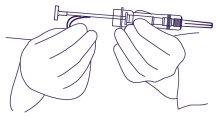 Рисунок 2
Рисунок 2
- Держать шприцу вокруг системы защиты, используя асептическую технику. Взять кожный склад пациента и ввести иглу под небольшим углом (30-45 градусов).
С открытием иглы вверх, ввести иглу в подкожную тканьпередней брюшной стенки под линией пупка, пока система защиты не коснется кожи пациента. (Рисунок 3).
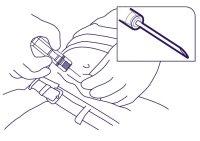 Рисунок 3
Рисунок 3
ПРИМЕЧАНИЕ: Шприца Золадекс 3,6 мг не может быть использована для аспирации. Если гиподермическая игла проникает в крупный сосуд, кровь сразу же появится в камере шприцы. Если проникновение в сосуд произошло, удалить иглу и немедленно контролировать любое возникшее кровотечение, наблюдая за пациентом на предмет любых признаков или симптомов внутрибрюшного кровотечения. После того, как будет подтверждено, что пациент гемодинамически стабилен, можно ввести другой имплантат Золадекс 3,6 мг с помощью новой шприцы в другую область. Будьте крайне осторожны, когда вводите Золадекс 3,6 мг пациентам с низким ИМТ и/или пациентам, получающим полные дозы антикоагулянтов.
- Не проникать в мышцу или перитонеум.На рисунке 4 ниже показаны неправильная фиксация и угол обнажения.
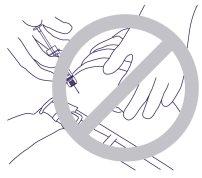 Рисунок 4
Рисунок 4
- Нажать на поршень полностью, пока он не может быть нажат дальше, чтобы разместить имплантат Золадекс 3,6 мг и активировать систему защиты. Можно услышать щелчок и почувствовать, как система защиты сдвигается автоматически, чтобы покрыть иглу. Если поршень не нажат полностью, система защиты небудет активирована.
ПРИМЕЧАНИЕ:Игла не втягивается.
- Продолжать держать шприцу, как показано на рисунке 5, удалить иглу, позволяя системе защиты продолжать сдвигаться и покрывать иглу.
Утилизировать шприцу в контейнере, в соответствии с местными правилами.
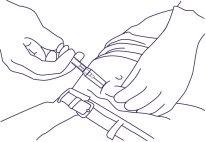 Рисунок 5
Рисунок 5
ПРИМЕЧАНИЕ: В случае необходимости хирургического удаления имплантата Золадекс 3,6 мг, его можно локализовать с помощью ультразвука.

Сколько стоит ЗОЛАДЕКС 3,6 мг ИМПЛАНТ В ПРЕДНАПОЛНЕННОМ ШПРИЦЕ в Испании в 2025 году?
Средняя цена на ЗОЛАДЕКС 3,6 мг ИМПЛАНТ В ПРЕДНАПОЛНЕННОМ ШПРИЦЕ в ноябрь, 2025 года составляет около 106.31 евро. Финальная стоимость может зависеть от региона, конкретной аптеки и рецептурного статуса. Для точной информации лучше проверить онлайн или в ближайшей аптеке.
- Страна регистрации
- Средняя цена в аптеках106.31 EUR
- Активное вещество
- Требуется рецептДа
- Производитель
- Информация носит справочный характер и не является медицинской рекомендацией. Перед приемом любых препаратов проконсультируйтесь с врачом. Oladoctor не несет ответственности за медицинские решения, принятые на основе этого контента.
- Аналоги ЗОЛАДЕКС 3,6 мг ИМПЛАНТ В ПРЕДНАПОЛНЕННОМ ШПРИЦЕФорма выпуска: ИМПЛАНТ, 10,8 мгАктивное вещество: гозерелинаПроизводитель: Astrazeneca Farmaceutica Spain S.A.Требуется рецептФорма выпуска: ИНЪЕКЦИОННЫЙ РАСТВОР, 42 мгАктивное вещество: leuprorelinПроизводитель: Accord Healthcare S.L.U.Требуется рецептФорма выпуска: ИНЪЕКЦИОННЫЙ РАСТВОР, 0,1 мгАктивное вещество: трипторелинаПроизводитель: Ipsen Pharma S.A.Требуется рецепт
Аналоги ЗОЛАДЕКС 3,6 мг ИМПЛАНТ В ПРЕДНАПОЛНЕННОМ ШПРИЦЕ в других странах
Лучшие аналоги с тем же действующим веществом и терапевтическим эффектом.
Аналог ЗОЛАДЕКС 3,6 мг ИМПЛАНТ В ПРЕДНАПОЛНЕННОМ ШПРИЦЕ в Польша
Аналог ЗОЛАДЕКС 3,6 мг ИМПЛАНТ В ПРЕДНАПОЛНЕННОМ ШПРИЦЕ в Украина
Врачи онлайн по ЗОЛАДЕКС 3,6 мг ИМПЛАНТ В ПРЕДНАПОЛНЕННОМ ШПРИЦЕ
Консультация по дозировке, побочным эффектам, взаимодействиям, противопоказаниям и продлению рецепта на ЗОЛАДЕКС 3,6 мг ИМПЛАНТ В ПРЕДНАПОЛНЕННОМ ШПРИЦЕ – по решению врача и с учетом местных правил.










